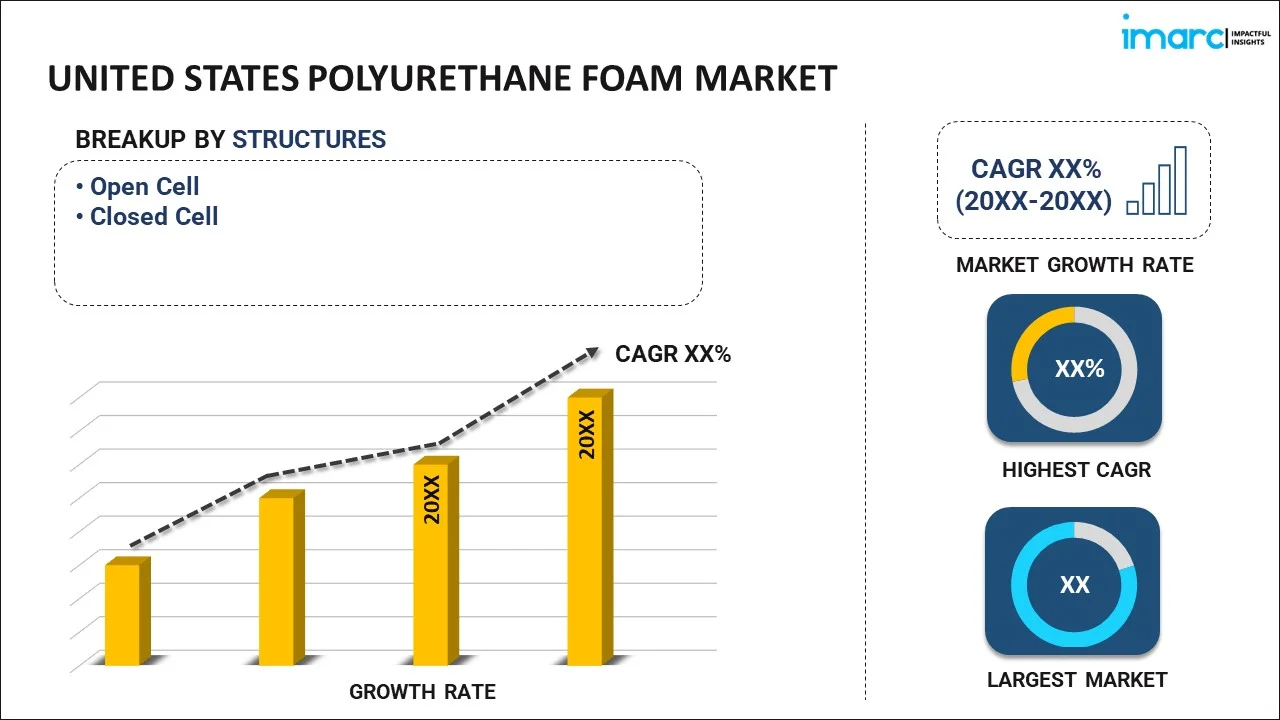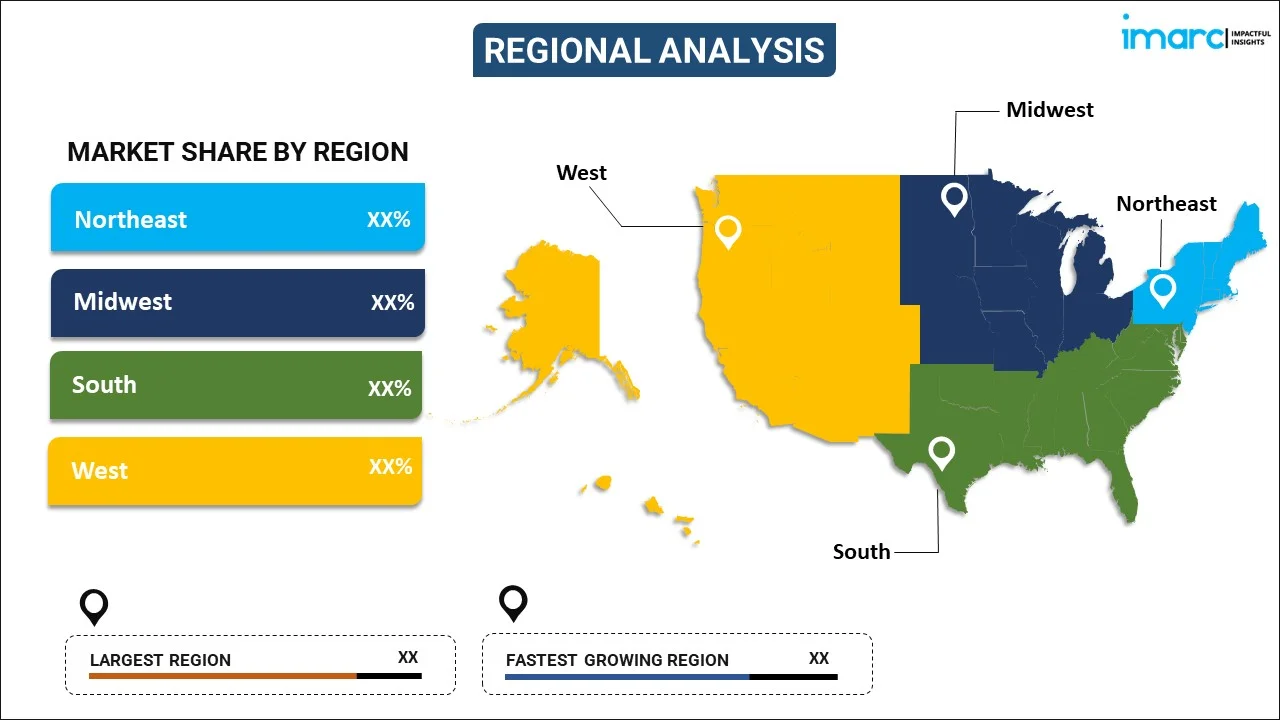
United States Polyurethane Foam Market Report by Structure (Open Cell, Closed Cell), Product Type (Flexible Foam, Rigid Foam, Spray Foam), Density (Low Density, Medium Density, High Density), End Use Industry (Bedding and Furniture, Building and Construction, Electronics, Automotive, Packaging, Footwear, and Others), and Region 2025-2033
Market Overview:
United States polyurethane foam market size reached USD 12.1 Billion in 2024. Looking forward, IMARC Group expects the market to reach USD 19.8 Billion by 2033, exhibiting a growth rate (CAGR) of 5.2% during 2025-2033. Continuous advancements in the packaging industry, along with the introduction of enhanced materials in numerous forms, are primarily driving the market growth.
|
Report Attribute
|
Key Statistics
|
|---|---|
|
Base Year
|
2024
|
|
Forecast Years
|
2025-2033
|
|
Historical Years
|
2019-2024
|
|
Market Size in 2024
|
USD 12.1 Billion |
|
Market Forecast in 2033
|
USD 19.8 Billion |
| Market Growth Rate 2025-2033 | 5.2% |
United States Polyurethane Foam Market Analysis:
- Key Market Drivers: The market is driven by growth in construction and transportation industries due to the demand for effective thermal insulation and light weight. Energy conservation regulations and development of infrastructure are further contributing to mass adoption across residential and commercial sectors, propelling United States polyurethane foam growth.
- Key Market Trends: The industry is witnessing a trend towards green manufacturing with more use of bio-based materials and low-emission products. Moreover, spray foam insulation is also becoming popular for its ability to improve building performance and keep pace with changing efficiency requirements.
- Competitive Landscape: Innovation in product formulation and application technology development are driving competition in the market. Firms are prioritizing capacity increases as well as strengthening distribution channels, with an ever-stronger focus on differentiation based on sustainable and performance-oriented solutions specific to different end-use markets.
- Challenges and Opportunities: According to United States polyurethane foam market analysis, volatile input prices and regulatory challenges pose operating challenges. Still, expanding demand for high-performance foams in automotive, building, and packaging industries provides significant scope for innovation and market growth, especially in green building and lightweighting endeavors.
Polyurethane foam, a synthetic polymer, serves as a protective and insulating material guarding against abrasion, temperature variations, moisture, impact, and corrosion. This versatile substance is readily accessible in spray, flexible, and rigid forms, commonly employed as stuffing in furniture and bedding. Known for its hypoallergenic and non-toxic properties, polyurethane foam retains its integrity over time. Notably, its rapid reaction with moisture enables expansion and bonding upon application, ensuring high adhesion to surfaces. Beyond its predominant use in furniture, polyurethane foam sees widespread utilization in diverse industries, including automotive, packaging, construction, and electronics, highlighting its adaptability and value across various applications.
United States Polyurethane Foam Market Trends:
Sustainable Innovation Fuels Material Reformulation
According to United States polyurethane foam market analysis, the market is experiencing profound change with the emergence of sustainability-driven innovations. With tightening environmental regulations and consumer preference shifting toward greener options, manufacturers are reformulating polyurethane foam more and more using bio-based polyols and low-emission blowing agents. These materials minimize environmental impact while keeping performance levels in automotive, construction, and furniture applications. The use of recyclable and renewable feedstocks is consistent with circular economy values and contributes to end-user industry brand value. Water-blown and non-halogenated flame-retardant chemistries are also becoming more prominent, aligning with wider decarbonization ambitions. The change not only encourages compliance with changing federal environmental regulations but also drives technological innovation in foam chemistry. United States polyurethane foam market trends postulate that environmentally friendly product development will continue to be a key strategic driver to increase market share. Consequently, market analysis prescribes significant growth opportunities in green product sectors.
Growing Demand in Residential and Commercial Insulation
Escalating application of foam in residential and commercial insulation is one of the key trends fueling the market growth. Polyurethane foam provides better thermal resistance and air-sealing, making it perfect for energy-saving buildings. As energy saving becomes increasingly popular in U.S. states, wall cavities, roof systems, and underfloor use of spray polyurethane foam (SPF) are gaining pace. This is also backed by government support for retrofitting existing buildings and optimizing HVAC efficiency. In addition, the increasing emphasis on zero-energy building codes and LEED certification continues to spur the deployment of high-performance insulating materials. Builders and architects increasingly use polyurethane foam for its low permeability and long-term durability, which save on operation costs. With construction activity picking up and infrastructure upgrades accelerating, the United States polyurethane foam market share in insulation solutions is likely to climb high, fueled by its energy efficiency and flexibility of installation.
Lightweighting in Transportation Applications
Within the transportation industry, one key trend that is transforming the size of the market is the continued trend toward lightweighting. Polyurethane foam is widely applied in automotive interior applications, headliners, cushioning in seats, and noise-reducing components because of its beneficial weight-to-strength ratio. With regulatory focus on the fuel efficiency and electric vehicle performance, car makers are shifting more and more towards integrating lighter materials to enhance vehicle performance and lower emissions. Aerospace and the rail industries are using rigid polyurethane foams for structural support and thermal insulation in lightweight composite panels. This emphasis on weight loss without compromise of safety or comfort makes polyurethane foam a key material in contemporary mobility engineering. Further, the increasing popularity of electric vehicles has necessitated new design issues, where flexible and rigid foam types play a role in battery case insulation and vibration management. These developments support the market trends, highlighting the changing position of the material in transportation innovations.
United States Polyurethane Foam Market Segmentation:
IMARC Group provides an analysis of the key trends in each segment of the market, along with forecasts at the country level for 2025-2033. Our report has categorized the market based on structure, product type, density, and end use industry.
Structure Insights:

To get more information on this market, Request Sample
- Open Cell
- Closed Cell
The report has provided a detailed breakup and analysis of the market based on the structure. This includes open cell and closed cell.
Product Type Insights:
- Flexible Foam
- Rigid Foam
- Spray Foam
A detailed breakup and analysis of the market based on the product type have also been provided in the report. This includes flexible foam, rigid foam, and spray foam.
Density Insights:
- Low Density
- Medium Density
- High Density
The report has provided a detailed breakup and analysis of the market based on the density. This includes low density, medium density, and high density.
End Use Industry Insights:
- Bedding and Furniture
- Building and Construction
- Electronics
- Automotive
- Packaging
- Footwear
- Others
A detailed breakup and analysis of the market based on the end use industry have also been provided in the report. This includes bedding and furniture, building and construction, electronics, automotive, packaging, footwear, and others.
Regional Insights:

- Northeast
- Midwest
- South
- West
The report has also provided a comprehensive analysis of all the major regional markets, which include Northeast, Midwest, South, and West.
Competitive Landscape:
The market research report has also provided a comprehensive analysis of the competitive landscape. Competitive analysis such as market structure, key player positioning, top winning strategies, competitive dashboard, and company evaluation quadrant has been covered in the report. Also, detailed profiles of all major companies have been provided.
Latest News and Developments:
- In June 2025, JLR, Adient, and Dow have made a circularity milestone in automotive seating using polyurethane foam cushions containing 20% recycled re-polyol. This innovation cuts CO₂ emissions and waste by more than half, enabling sustainable vehicle production. Commercial-scale roll-out of the recycled foam seats is planned for 2026.
- In March 2025, BASF introduced biomass balance grades of its Elastoflex® polyurethane foam systems for the North American furniture market with the goal of reducing product carbon footprint by up to 75% while using conventional foam performance and aiding industry sustainability objectives. Its Livonia, Michigan facility is REDcert² certified.
United States Polyurethane Foam Market Report Coverage:
| Report Features | Details |
|---|---|
| Base Year of the Analysis | 2024 |
| Historical Period | 2019-2024 |
| Forecast Period | 2025-2033 |
| Units | Billion USD |
| Scope of the Report | Exploration of Historical and Forecast Trends, Industry Catalysts and Challenges, Segment-Wise Historical and Predictive Market Assessment:
|
| Structures Covered | Open Cell, Closed Cell |
| Product Types Covered | Flexible Foam, Rigid Foam, Spray Foam |
| Densities Covered | Low Density, Medium Density, High Density |
| End Use Industries Covered | Bedding and Furniture, Building and Construction, Electronics, Automotive, Packaging, Footwear, Others |
| Regions Covered | Northeast, Midwest, South, West |
| Customization Scope | 10% Free Customization |
| Post-Sale Analyst Support | 10-12 Weeks |
| Delivery Format | PDF and Excel through Email (We can also provide the editable version of the report in PPT/Word format on special request) |
Key Benefits for Stakeholders:
- IMARC’s industry report offers a comprehensive quantitative analysis of various market segments, historical and current market trends, market forecasts, and dynamics of the United States polyurethane foam market from 2019-2033.
- The research report provides the latest information on the market drivers, challenges, and opportunities in the United States polyurethane foam market.
- Porter's five forces analysis assist stakeholders in assessing the impact of new entrants, competitive rivalry, supplier power, buyer power, and the threat of substitution. It helps stakeholders to analyze the level of competition within the United States polyurethane foam industry and its attractiveness.
- Competitive landscape allows stakeholders to understand their competitive environment and provides an insight into the current positions of key players in the market.
Key Questions Answered in This Report
The polyurethane foam market in the United States was valued at USD 12.1 Billion in 2024.
The United States polyurethane foam market is projected to exhibit a (CAGR) of 5.2% during 2025-2033, reaching a value of USD 19.8 Billion by 2033.
Major drivers of the market are increased energy-efficient insulation demand, expansion in construction and automotive industries, focus on light and resilient materials, and expanding use in furniture and packaging. Governmental incentives and sustainability trends also enhance adoption across various end-use industries.
Need more help?
- Speak to our experienced analysts for insights on the current market scenarios.
- Include additional segments and countries to customize the report as per your requirement.
- Gain an unparalleled competitive advantage in your domain by understanding how to utilize the report and positively impacting your operations and revenue.
- For further assistance, please connect with our analysts.
 Request Customization
Request Customization
 Speak to an Analyst
Speak to an Analyst
 Request Brochure
Request Brochure
 Inquire Before Buying
Inquire Before Buying




.webp)




.webp)












